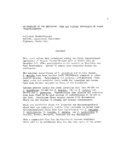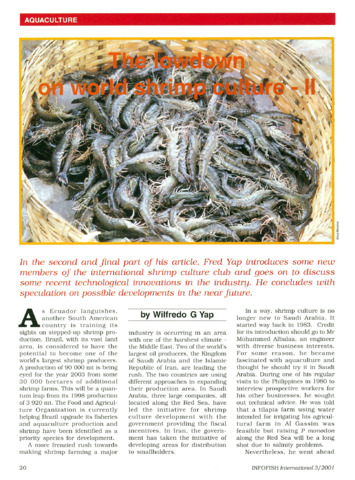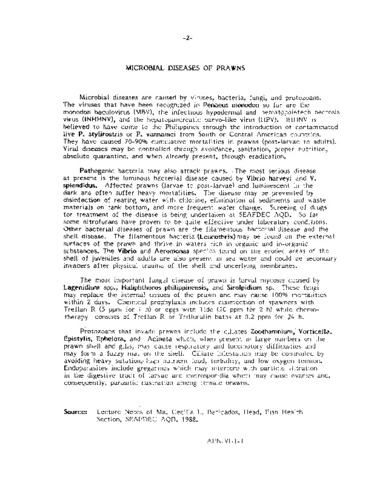Acute hepatopancreatic necrosis disease (AHPND) outbreaks in Penaeus vannamei and P. monodon cultured in the Philippines
Share
| dc.contributor.author | de la Peña, Leobert D. | |
| dc.contributor.author | Cabillon, Nikko Alvin R. | |
| dc.contributor.author | Catedral, Demy D. | |
| dc.contributor.author | Amar, Edgar C. | |
| dc.contributor.author | Usero, Roselyn C. | |
| dc.contributor.author | Monotilla, Wilberto D. | |
| dc.contributor.author | Calpe, Adelaida T. | |
| dc.contributor.author | Fernandez, Dalisay DG. | |
| dc.contributor.author | Saloma, Cynthia P. | |
| dc.date.accessioned | 2016-12-06T03:16:11Z | |
| dc.date.available | 2016-12-06T03:16:11Z | |
| dc.date.issued | 2015 | |
| dc.identifier.citation | de la Peña, L. D., Cabillon, N. A. R., Catedral, D. D., Amar, E. C., Usero, R. C., Monotilla, W. D., ... Saloma, C. P. (2015). Acute hepatopancreatic necrosis disease (AHPND) outbreaks in Penaeus vannamei and P. monodon cultured in the Philippines. Diseases of Aquatic Organisms, 116(3), 251-254. | en |
| dc.identifier.issn | 0177-5103 | |
| dc.identifier.uri | http://hdl.handle.net/10862/3081 | |
| dc.description.abstract | Acute hepatopancreatic necrosis disease (AHPND) has recently emerged as a serious disease of cultured shrimp. It has also been described as early mortality syndrome (EMS) due to mass mortalities occurring within 20 to 30 d after stocking of ponds with postlarvae. Here, Penaeus vannamei and Penaeus monodon from shrimp farms in the Philippines were examined for the toxin-producing strain of Vibrio parahaemolyticus due to AHPND-like symptoms occurring in marketable size shrimp. In the P. vannamei, histology revealed typical AHPND pathology, such as sloughing of undifferentiated cells in the hepatopancreatic tubule epithelium. Analysis using the IQ2000 AHPND/EMS Toxin 1 PCR test generated 218 bp and 432 bp amplicons confirmative of the toxin-producing strain of V. parahaemolyticus among shrimp sampled from 8 of 9 ponds. In the P. monodon, histology revealed massive sloughing of undifferentiated cells of the hepatopancreatic tubule epithelium in the absence of basophilic bacterial cells. PCR testing generated the 2 amplicons confirmatory for AHPND among shrimp sampled from 5 of 7 ponds. This study confirms the presence of AHPND in P. vannamei and P. monodon farmed in the Philippines and suggests that the disease can also impact late-stage juvenile shrimp. | en |
| dc.description.sponsorship | We are very grateful to DOST-PCAARRD and SEAFDEC/AQD for funding this work and to the Shrimp Pathogenomics team, especially Dr. N. R. L. Rojas and Dr. E. P. Enriquez. We thank the shrimp farms that provided the samples and the staff of Fish Health Section Diagnostic Services and Microtechnique Lab for the technical support. We also thank T. W. Flegel for confirming our histological analysis and for assistance in editing the manuscript. | en |
| dc.language.iso | en | en |
| dc.publisher | Inter Research | en |
| dc.relation.uri | https://www.int-res.com/articles/dao2015/116/d116p251.pdf | |
| dc.subject | Penaeus monodon | en |
| dc.subject | Decapoda | en |
| dc.subject | Vibrio parahaemolyticus | en |
| dc.subject | Penaeus vannamei | en |
| dc.subject | Philippines | en |
| dc.title | Acute hepatopancreatic necrosis disease (AHPND) outbreaks in Penaeus vannamei and P. monodon cultured in the Philippines | en |
| dc.type | Article | en |
| dc.citation.volume | 116 | |
| dc.citation.issue | 3 | |
| dc.citation.spage | 251 | |
| dc.citation.epage | 254 | |
| dc.citation.journalTitle | Diseases of Aquatic Organisms | en |
| dc.subject.asfa | symptoms | en |
| dc.subject.asfa | pathology | en |
| dc.subject.asfa | shrimp culture | en |
| dc.subject.asfa | nucleotide sequence | en |
| dc.subject.asfa | DNA | en |
| dc.subject.asfa | polymerase chain reaction | en |
| dc.subject.asfa | microbiological strains | en |
| dc.subject.asfa | ponds | en |
| dc.subject.asfa | hepatopancreas | en |
| dc.subject.asfa | histopathology | en |
| dc.identifier.essn | 1616-1580 | |
| dc.identifier.doi | 10.3354/dao02919 | |
| dc.subject.scientificName | Penaeus monodon | en |
| dc.subject.scientificName | Penaeus vannamei | en |
Files in this item
| Files | Size | Format | View |
|---|
This item appears in the following Collection(s)
-
AQD Journal Articles [1249]
These papers were contributed by AQD staff to various national and international journals



